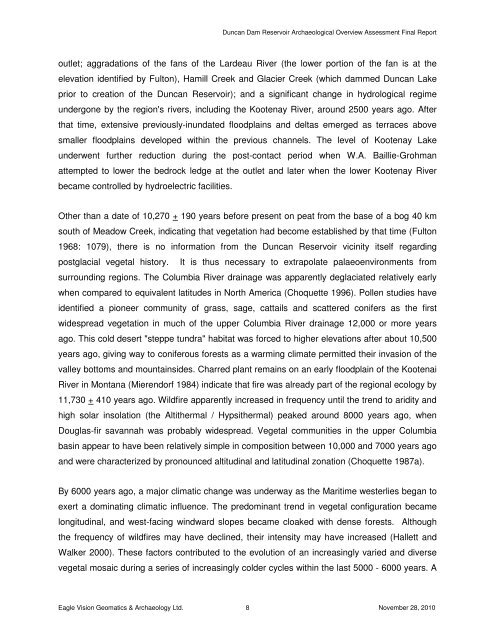November 2010 - BC Hydro
November 2010 - BC Hydro
November 2010 - BC Hydro
Create successful ePaper yourself
Turn your PDF publications into a flip-book with our unique Google optimized e-Paper software.
Duncan Dam Reservoir Archaeological Overview Assessment Final Report<br />
outlet; aggradations of the fans of the Lardeau River (the lower portion of the fan is at the<br />
elevation identified by Fulton), Hamill Creek and Glacier Creek (which dammed Duncan Lake<br />
prior to creation of the Duncan Reservoir); and a significant change in hydrological regime<br />
undergone by the region's rivers, including the Kootenay River, around 2500 years ago. After<br />
that time, extensive previously-inundated floodplains and deltas emerged as terraces above<br />
smaller floodplains developed within the previous channels. The level of Kootenay Lake<br />
underwent further reduction during the post-contact period when W.A. Baillie-Grohman<br />
attempted to lower the bedrock ledge at the outlet and later when the lower Kootenay River<br />
became controlled by hydroelectric facilities.<br />
Other than a date of 10,270 + 190 years before present on peat from the base of a bog 40 km<br />
south of Meadow Creek, indicating that vegetation had become established by that time (Fulton<br />
1968: 1079), there is no information from the Duncan Reservoir vicinity itself regarding<br />
postglacial vegetal history. It is thus necessary to extrapolate palaeoenvironments from<br />
surrounding regions. The Columbia River drainage was apparently deglaciated relatively early<br />
when compared to equivalent latitudes in North America (Choquette 1996). Pollen studies have<br />
identified a pioneer community of grass, sage, cattails and scattered conifers as the first<br />
widespread vegetation in much of the upper Columbia River drainage 12,000 or more years<br />
ago. This cold desert "steppe tundra" habitat was forced to higher elevations after about 10,500<br />
years ago, giving way to coniferous forests as a warming climate permitted their invasion of the<br />
valley bottoms and mountainsides. Charred plant remains on an early floodplain of the Kootenai<br />
River in Montana (Mierendorf 1984) indicate that fire was already part of the regional ecology by<br />
11,730 + 410 years ago. Wildfire apparently increased in frequency until the trend to aridity and<br />
high solar insolation (the Altithermal / Hypsithermal) peaked around 8000 years ago, when<br />
Douglas-fir savannah was probably widespread. Vegetal communities in the upper Columbia<br />
basin appear to have been relatively simple in composition between 10,000 and 7000 years ago<br />
and were characterized by pronounced altitudinal and latitudinal zonation (Choquette 1987a).<br />
By 6000 years ago, a major climatic change was underway as the Maritime westerlies began to<br />
exert a dominating climatic influence. The predominant trend in vegetal configuration became<br />
longitudinal, and west-facing windward slopes became cloaked with dense forests. Although<br />
the frequency of wildfires may have declined, their intensity may have increased (Hallett and<br />
Walker 2000). These factors contributed to the evolution of an increasingly varied and diverse<br />
vegetal mosaic during a series of increasingly colder cycles within the last 5000 - 6000 years. A<br />
Eagle Vision Geomatics & Archaeology Ltd. 8 <strong>November</strong> 28, <strong>2010</strong>

















